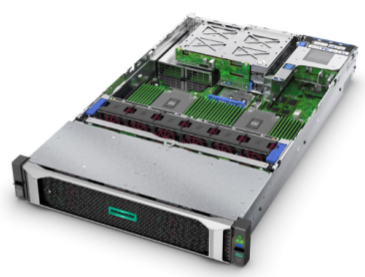Up to this point, we’ve covered two key responsibilities of an IT technician: setting up ready-to-use workstations and connecting them to the local network and ensuring that all of the component parts are talking to each other.
Let’s continue our exploration of the daily role of an IT technician and look at the tasks involved in IT infrastructure administration.
Install Servers
As you saw earlier, one of the main responsibilities of an IT technician is installing workstations, also known as client machines. However, another type of machine exists within almost all IT environments: servers.
Servers are how IT systems provide the resources, or services, that the workstations and other IT equipment will use.
Your role is to install these physical or virtual servers and connect them to the local network, exactly as you did for the workstations.
Dedicated Hardware and Operating System
A server and a computer operate almost identically and are made up of similar, if not identical, components. The difference is that a server is a more powerful machine used remotely by several computers simultaneously.

Let’s do a brief round-up of services that you will commonly find provided by servers within an organization.
Two (of Many Possible) Server Services
File sharing
One of the most important services for an organization is file storage sharing.
Department members (accounting, for example) must be able to work on the same documents; therefore, they shouldn't be stored locally on a single user's workstation.
A file server allows you to store data in a dedicated repository where access is authorized for a specific user or group of users by applying permissions.
Only staff working in a department, accounting, for example, can access the relevant folder or folders, which will be shared between them and contain all documents that relate to their work. You can configure the file server so that nobody outside of the accounts team will have access.
Directory Services
Let’s look at another essential service that applies to a Windows environment: Active Directory (AD). This directory server provides a central hierarchy of resources within the organization (computers, users, servers, groups, etc.).
You can use AD to give users permission to access resources on the network, apply security rules, control workstation features, and deploy software.
Another of your tasks is to create user IT accounts to allow them access to everything they need to do their work. In addition, you can authenticate users using these accounts.
Manage Access to Resources Within an Organization
To use the server resources, you must be able to identify and authenticate users. They must have:
Credentials that consist of a unique username.
A complex password (uppercase and lowercase letters and numbers) known only to them.
Your role is to provide them with their credentials to access the network. These will be used to log on to their computer, access their department's shared resources, send emails, and use business applications.
You’ll need to use the Active Directory service from the previous section to create credentials.
Let's Recap!
Your IT infrastructure administration tasks include:
Installing/configuring servers and connecting them to the organization’s network.
Using Active Directory to create user accounts to give them access to different services.
Managing access to server resources.
So, that’s your round-up of IT infrastructure administration. Now we can move on to the main role of an IT technician: supporting users.
